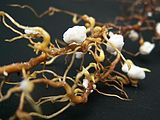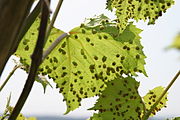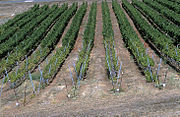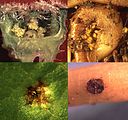Phylloxera
| Phylloxera | ||||||||||||
|---|---|---|---|---|---|---|---|---|---|---|---|---|

Phylloxera ( Daktulosphaira vitifoliae ) |
||||||||||||
| Systematics | ||||||||||||
|
||||||||||||
| Scientific name | ||||||||||||
| Daktulosphaira vitifoliae | ||||||||||||
| ( Fitch , 1855) |
The phylloxera ( Daktulosphaira vitifoliae , Syn . : Viteus vitifoliae ) is a plant louse from the family of dwarf lice (Phylloxeridae). Introduced into Europe as a neozoon from North America in the 19th century , it is still considered a major pest in viticulture today .
Due to different behaviors towards the grapevines, it has been found that there are different biotypes of phylloxera. Depending on the author, different names are used for the biotypes (biotype, performance type, strain, superclone). In California, a distinction is made between two phylloxera biotypes A and B, which differ in their aggressiveness towards the rootstock variety A × R 1 ( Vitis vinifera ('Aramon') × Vitis rupestris ).
anatomy
The phylloxera has the anatomical features of all insects . In contrast to other aphids , it lacks wax glands with which it could defend itself against attackers. In addition, the wings of the phylloxera are set up steeply. There are also differences between the individual forms of phylloxera: In the case of the root reblice ( Radicicolae ), only female animals with a maximum size of 1.35 millimeters are present, which are yellow or brownish-green in color. The female, winged phylloxera flies ( Sexuparae ) are about one millimeter in size and yellow-green to ocher in color. Male sex animals ( Sexuales ) have a life expectancy of up to eight days, are 0.28 millimeters in size and have a yellowish color. The females are slightly larger at 0.5 millimeters, and their color is slightly lighter than that of the males. Neither males nor females have a proboscis; they cannot take in any food. The Maigallenläuse ( founder on ) are grown to four molts and have a size between one and 1.25 millimeters.
Life cycle
Phylloxera cycle. Blackboard by Hinrich Nitsche , Leipzig 1882. Copy from the Humboldt University of Berlin
The life cycle of phylloxera is very complex, because it carries out a holocyclic host change between the vine and the vine root. Some root lice develop into winged nymphs in late autumn . The nymphs leave the ground and develop into winged phylloxera, the phylloxera flies. Now the above-ground development cycle begins. The phylloxera flies lay small male and large female eggs on the bark of the vine. From this hatch the trunkless sex animals ( Sexuales ), which mate. The mated females each lay a fertilized winter egg (0.27 × 0.13 mm) in a crack in the bark of the two to three year old wood. From this winter eggs hatch in spring in the Maigallenläuse ( founder on ), mainly on the leaves of American vines leaf galls develop and lay there until 1200 eggs. The pitcher-shaped gall body is on the underside of the leaf, the opening on the top of the leaf. There are again two types of larvae that hatch in the galls after eight to ten days. Some form leaf galls again, especially on younger leaves. The others, which also differ externally from the former, are leaf-born root lice and seek out the vine roots in the soil. There they supplement the underground development cycle or start it again. The number of those that migrate to the secondary host increases with each generation of larvae until they are all at the roots in the soil. However, they do not attack the roots immediately, but first migrate to even deeper layers of soil, where they overwinter. In the following spring they look for young vine roots in order to take up food and complete their development into egg-laying females. In the root areas constant unisex reproduction is possible by the larvae ( Hiemales ) that overwinter on the secondary host . Some of the root lice develop again into phylloxera flies, which in turn come out of the earth and begin the above-ground cycle. Offspring with new genetic material only emerge in the above-ground cycle, since there are only males and females there. These offspring can behave differently than the aphids and root lice, which are unisexual. Because of the lower temperatures in Central Europe (except in the climatically warmer southwest), reproduction is mainly unisexual ( anholocyclic ).
history
The aphid relative, which originated in North America, was introduced through vines from the east coast of America via London to southern France in the 1860s (proven from 1863) and spread rapidly from there to all European wine-growing regions during the phylloxera invasion . As a result, there was dramatic devastation in European viticulture, the so-called "phylloxera crisis" or "phylloxera catastrophe".
France was particularly hard hit. Between 1865 and 1885, phylloxera destroyed large parts of the French wine-growing regions, which were only replaced by new vines from America around 1850 after the powdery mildew crisis . This had catastrophic consequences for French agriculture. In total, almost 2.5 million hectares of vineyards were destroyed in France alone. In 1870 the French government set up a phylloxera control commission chaired by the chemist Jean-Baptiste Dumas . In 1885, Louis Pasteur , who had previously been a member of the commission, succeeded him as chairman. The efforts of the commission were unsuccessful in the long term, however, because they preferred chemical pest control and not the use of resistant rhizomes, which was mainly practiced in Montpellier by Jules Émile Planchon and his students. Planchon worked closely with American grape growers and viticulture scientists such as George Hussman (1827–1903), professor of agriculture at the University of Missouri in Columbia, Charles Valentine Riley (1843–1895), state entomologist, the winemaker and grapevine grower Hermann Jaeger (1844–1895) 1895) from Neosho (Missouri) and the Texan vine grower Thomas Volney Munson (1843-1913) together. The American winemakers sent him phylloxera-resistant American grape varieties that Planchon used as a base for French noble varieties.
Phylloxera first appeared in Klosterneuburg in the Wagram wine-growing area in 1867, in German wine-growing areas for the first time in 1874 near Bonn in the Annaberg gardens , around 1885 in Loschwitz near Dresden (see also phylloxera disaster in the Lößnitz ), 1907 in the Mosel-Saar-Ruwer Area and in 1913 in the Baden wine-growing region .
Phylloxera is currently experiencing a renaissance due to climate changes, fallow vineyards and the increasing number of domestic vines (ornamental vines).
Damage to the vine
In itself the phylloxera is an occasional pest. Epidemics can occur through monocultures. The aphid is the lesser of two evils, it only affects growth when the infestation is extremely strong. The most significant damage is caused by the root reblice, as the vascular tissue of the roots is damaged by their sucking activity . The consequence for the plant is a lack of water and nutrients, which can lead to the death of the vine.
Secondary infections from bacteria , fungi and viruses pose a further risk .
Root revolutions on a nodule (a nodular thickening).
Combat
Biotechnical control
To combat phylloxera-resistant " rootstock " from America ( Vitis riparia , Vitis berlandieri , Vitis rupestris , Vitis cinerea or their hybrids made from them ) are grafted (grafted) with native vines ( Vitis vinifera ) . This can interrupt the complicated reproductive cycle of phylloxera. Almost all vineyards in the world are now on a suitable rootstock, adapted to the location.
Reactions on leaves and roots in rootstocks and rootstocks tolerant to vine blue (upper half of the picture). Formation of necrosis as a result of a hypersensitivity reaction when stung by phylloxera in phylloxera-resistant rootstock varieties ( Börner rootstock ) and seedlings (lower half of the picture).
In yield viticulture worldwide there are only a few locations or areas where non-grafted vines can be (non-grafted, not refined) planted. Sandy soils have the advantage that phylloxera cannot develop here. That is why such vineyards were the only ones spared during the phylloxera disaster, for example in Hungary's viticulture .
Chemical control
Soil injection with carbon disulfide ( carbon disulfide ) was an effective, but laborious and expensive method of phylloxera control. The liquid, easily evaporating, highly flammable and poisonous carbon disulfide was brought into the main root area of infected vines with hand injectors. By refining the noble variety with a resistant rootstock, this possibility has long since disappeared and has been banned since 1997.
"The phylloxera" - music and poetry
Karl Föderl (music) and Ernst Marischka (text) set a musical monument to phylloxera with the Viennese song Die Phylloxera . In Marischka's 1940 film Seven Years of Bad luck , Hans Moser explains singingly why he is so fond of wine: I must have been phylloxera in my earlier life .
literature
- Karl Bauer among others: Viticulture. 8th edition. Österreichischer Agrarverlag, Vienna 2008, ISBN 3-7040-1765-5 .
- Victor Fatio: The Phylloxera (phylloxera). Brief instructions for use by cantonal and federal experts in Switzerland. Translated into German by H. Krämer. 2nd Edition. Aarau 1879.
- Stauffacher, Heinrich: The Phylloxera vastatrix Pl. In the canton of Thurgau 1896-1921. Frauenfeld 1922.
- Hermann Goethe: The phylloxera. A popular instruction about the characteristics and way of life of this most dangerous enemy of the vine with an indication of the measures to be taken against it. Graz 1881 ( digitized version ).
- Walter Hillebrand, Dieter Lorenz, Friedrich Louis: Vine protection. 11th edition. Fachverlag Fraund, Mainz 1998, ISBN 3-921156-36-X .
- Werner Jacobs (greeting), Maximilian Renner (cont.): Biology and ecology of insects. 2nd Edition. Gustav Fischer, Jena 1989, ISBN 3-334-00334-5 .
- Hanns-Heinz Kassemeyer , Günter Schruft: Diseases and pests of the grapevine. Th. Mann, Gelsenkirchen 1999, ISBN 3-7862-0112-9 .
- Jos. A. Massard: A hundred years ago: The phylloxera is here! An uninvited guest from America puts Luxembourg's viticulture in danger. In: Lëtzebuerger Journal. No. 143 (July 27), 2007, pp. 19-21 ( PDF ).
See also
Web links
- champagner.com - phylloxera
- Phylloxera will be combated in the Kaiserstuhl at the end of 2011. In: Badische Zeitung , January 13, 2011
Individual evidence
- ↑ Christoph Hoffmann: Phylloxera technical discussion at the Institute for Plant Protection in Fruit and Viticulture, Siebeldingen. (PDF) In: Journal für Kultur Pflanzen No. 63. 2011, pp. 340 to 343 , accessed on April 15, 2015 (with further references).
- ↑ Andreas Kopf: Studies on the abundance of phylloxera ( Dactylosphaera vitifolii Shimer) and the formation of nodosities depending on environmental factors, dissertation . Ed .: University of Hohenheim . 2000 ( full text [PDF; 2.5 MB ]).
- ^ Carlo Alberto Redi, Silvia Garagna, Maurizio Zuccotti, Ernesto Capanna, Helmut Zacharias: Visual Zoology: The Pavia collection of Leuckart's zoological wall charts. Ibis, Como, Pavia 2002. ISBN 88-7164-130-2 . → Phylloxera: page 122.
- ^ Science, Vine and Wine in Modern France, Harry W. Paul, p. 38.
- ↑ Research Viticulture, Agricultural Industry Association (PDF; 162 kB)















